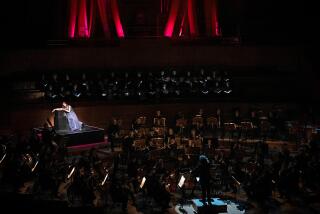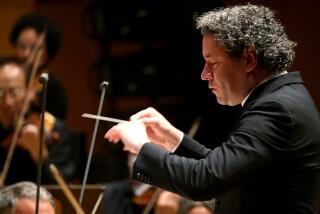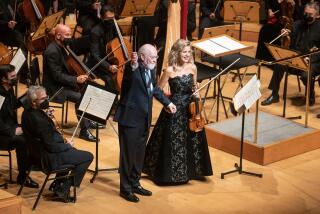Toe-to-Toe With Lully
- Share via
Most music lovers know the tragicomic story of Jean-Baptiste Lully’s untimely demise. He was conducting a piece in his usual manner--by raising and lowering a long, pointed cane, which he occasionally banged on the floor to make sure the musicians kept the beat.
In one exuberant moment, he struck his foot with the cane’s sharp point. An abscess developed on a toe. Because he refused to let a doctor amputate it, gangrene set in, spreading rapidly and causing a painful death.
How many of the people who know the story, however, know what piece he was conducting?
It was his Te Deum, composed in 1677 for the baptism of his oldest son, Louis. This work, rarely performed because of its grim history, closes the 21st annual Baroque Music Festival Corona del Mar on Sunday at St. Michael & All Angels Episcopal Church.
“I’m going to attempt to do a not-too-authentic performance,” festival director Burton Karson said in a phone interview, alluding to Lully’s mishap.
The festival this year emphasizes French and Italian composers, hence the French Lully, as well as Couperin and the less frequently encountered Blavet, Boismortier and Leclair.
Works by these composers, plus Italians Albinoni, Vivaldi and Brescianello, will be played Friday evening in the second of two chamber music programs at the Sherman Library & Gardens.
The musicians will include flutist David Shostac, bassoonist Michael O’Donovan, violinist Clayton Haslop and harpsichordist Gabriel Arregui.
Adrian Banchieri’s “Barca di Venetia per Padova” (“Boat From Venice to Padua”), a dramatic madrigal cycle of 20 pieces, is the sole offering on Wednesday at the Sherman Library.
“It’s one of the most humorous pieces ever written,” Karson said. “It doesn’t make fun of anyone. It just has fun with all the passengers.”
The piece will be sung in Italian, but there will be narration in English before each madrigal. The work also will be semi-staged, with the singers standing behind a gondola cutout, and with painted backdrops to suggest the stages of the journey.
Johann Sebastian Bach makes an appearance on the Sunday program in the form of his Lutheran Mass in G, a work which, like all the Lutheran Masses, consists only of the Kyrie and Gloria drawn from the Roman Mass.
“All the parts are borrowed from cantatas he wrote previously, all written for different words,” Karson said. “Somehow he pushed and pulled the Greek Kyrie and the Latin Gloria into something that is almost singable.
“It’s extraordinarily difficult to sing. The opening Kyrie is very introspective, chromatic and pleading. The final chorus has been described by several scholars as some of Bach’s most glorious music.”
Opening the three-part choral finale is Carissimi’s “Jephte,” which draws on the familiar story in the Book of Judges.
Jephthah (in the English spelling) makes a vow to the Lord that if he wins the upcoming battle with the Ammonites, he will sacrifice the first person who comes out of his house to meet him after the battle.
Unfortunately, that person turns out to be his daughter, his only child.
“She doesn’t protest his vow, but she does ask for a delay of two months so she can go up to the mountains and lament. She doesn’t lament that she must die, but that she must die a virgin. The work has a lamentation chorus that is simply heart-rending, it’s so wonderfully emotional.”
The Lully Te Deum closes the program and the festival.
“It was written for the baptism of Lully’s son,” Karson said. “[King] Louis [XIV] was the godfather, but it took him 13 years to agree to attend a ceremony! Lully conducted it then, then once again at a royal wedding and a third time, in 1687, to commemorate the recent recuperation of the king. That was the concert in which he stabbed his foot, developed gangrene and died.”
Though in the midst of this festival, Karson can’t help thinking about the future.
“Next year, I’m already thinking toward more English music and perhaps Handel and Purcell,” he said. “I try to make the festival enjoyable for the performers and I think about entertaining the audience. We have so many of our audience members returning year after year, I must give them contrasting music.”
More to Read
The biggest entertainment stories
Get our big stories about Hollywood, film, television, music, arts, culture and more right in your inbox as soon as they publish.
You may occasionally receive promotional content from the Los Angeles Times.










